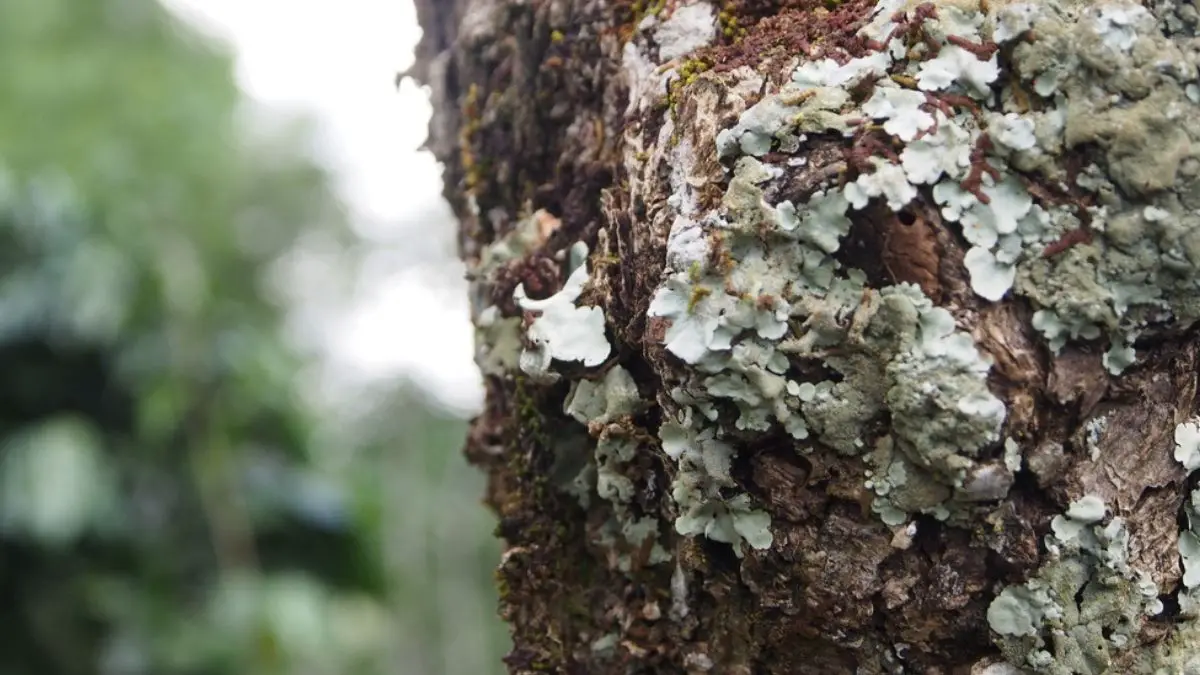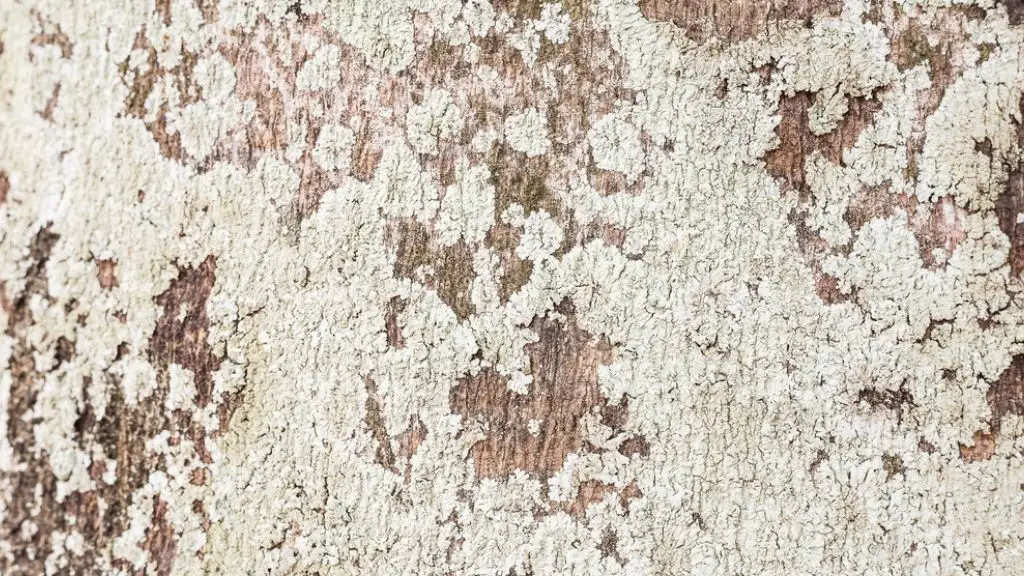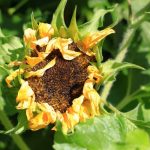What Causes White Growth on the Tree Trunk? Know Now!

Trees that are healthy, vigorous, and showy are a sight to behold. However, when a tree’s look is impaired by a foreign substance, such as white growth on the tree trunk, all of the tree’s positive characteristics can be inhibited by the sight of that unpleasant flaw. And, while we’re on the subject, what is that white fluff on a tree?
There are many types of fungus on trees. Most common are lichen, wet wood, powdery mildew that can cause white fungus. But are they dangerous? Is there anything we can do to fix this white growth problem?
In this article, we are going to discuss some of these factors and how to cure them.
What are the Causes of White Growth on the Tree Trunk
Growers frequently post this, why is my tree trunk turning white, and the causes are not what you expect. Following are the causes of the White growth on trees:
Tree Fungus (Powdery Mildew)
Powdery mildew is the white growth on the Tree trunk that resembles a fine dusting of flour or baby powder on the surface, hence the name. It forms in high-humidity circumstances, generally after the rain. You can see Powdery Mildew in dense plant areas and thick tree canopies that remain wet/damp after periods of heavy rain.
Powdery mildew on tree trunk flourishes in hot, dry conditions, but it also requires a high level of humidity, preferably the hot days and cool nights of late spring and early summer. Powdery mildew thrives in settings where there isn’t enough sunlight and there isn’t enough air circulation.
Although rarely lethal, it can cause major damage to your trees by depriving them of water and nutrients if left untreated. Furthermore, plants can become weak, bloomless, and develop slower as a result of most illnesses, which cause mild harm such as leaves turning yellow or getting withering.

Wet wood
Slime flux, commonly known as wet wood, is a widespread bacterial disease that affects a variety of trees. This white growth on the tree trunk has an effect on almost all elm and poplar species, as well as crabapple, beech, birch, maple, dogwood, horse chestnut, linden, oak, pine, redbud, sycamore, and tuliptree. Wet wood isn’t usually a serious illness, so have a little sigh of relief. However, a tree with a persistent case of wet wood, on the other hand, may lose its overall vigor.
A number of bacteria species penetrate the tree through wounds and create wet wood. Root wounds are likely a key point of the entrance of these bacteria. However, the infection has a limit as it infects only the sapwood and heartwood of the tree.
Wet wood is a water-soaked region in the wood where bacteria colonize. It ranges from dark brown to black and a sour-smelling liquid leaks from the tree. This leak is most commonly around tree crotches, bark fractures, or pruning scars.
When the liquid is inside the tree, it is colorless or pale, but in the presence of air, it darkens. When the liquid dries on the bark, it leaves a pale grey to the white crust which you see as “White Growth on the tree trunk”.
Lichen
Lichen is also a reason for white growth on the tree trunk. To begin with, lichen is not a plant, despite the fact that it grows and resembles one. Lichen is the outcome of a symbiotic interaction between a fungus and an alga or cyanobacterium, as well as sometimes another creature.
According to resources, lichens can cover more than 6% of the earth’s surface. There are nearly 20,000 different types, all with different colors and shapes. You can find them in humid forests, freezing places, and desert sands on every continent.
People frequently link lichen with old, decaying, or dead trees, assuming that the lichen is the white growth on a tree trunk. Lichen, on the other hand, tends to appear on trees that are already in decline. You can also find them on healthy, fast-growing trees infrequently. As lichen enjoys sunlight and moisture, it can be found in sunny, rainy areas.
When your tree loses leaves or a branch all of a sudden, it offers ideal circumstances for lichen to thrive. While lichen does not hurt your tree, its presence may indicate that the tree is ill or dying.

Insect Infestation (Woolly Aphids)
A woolly aphid colony on a tree may appear to be white growth on a tree trunk or mold at first glance. If you look at that closely, then you can see that they are actually insects that feed by sucking the tree’s fluid. While they may appear soft and fluffy, they can cause a variety of tree health problems, including curled or wilted leaves and stunted growth (in the worst-case scenario).
Woolly aphids feed by piercing plant tissue with their needle-like jaws. This enables them to extract sap. They eat leaves, buds, bark, and roots, among other things. Woolly aphids create a sticky fluid known as honeydew as a result of feeding on sap which leads to sooty mold.
White flux
Those who want to know what is the white stuff on tree trunks should know that white flux is also one of the causes of this whiteness.
White flux, also known as alcoholic flux, is another possible white growth that can affect sweetgum, oak, elm, and willow trees.
A bacteria causes this white growth on the tree trunks by fermenting sap that leaks or oozes from fractures and lesions in the bark. The end result is a white, foamy sludge with a beer-like fermenting stench.
This White spots on oak tree bark will not kill the tree; rather, it is a symptom that earlier harm has occurred. To your relief, the white flux may stop in a year or two as the exterior wound calluses over and internal methane production declines. However, these white spots on branches might recur year after year in some circumstances.
White Tree Fungus Identification
So, how you can identify that the white growth on the tree is fungus? White fungus, like other tree diseases, manifests itself in a few different ways. The leaves or needles may show irregular growth, yellowing, or withering while suffering from the fungus. Moreover, the bark may have discoloration or growth (scabs).
On some portions of your tree, you may see a dusting or coating. If you see unusual sogginess near your tree’s trunk, it could be an indication of root rot (fungal disease). Finally, throughout the growing season, you may notice “die-off,” where leaves or needles fall off and branches get dry.
Is white fungus on trees dangerous?
Some white substances that grow on trees are oak wilt, heart rot, lichens, powdery mildew, and wet wood. You must be wondering are these substances dangerous for our trees or not? The answer is that some white growth on the tree trunk may harm your trees like powdery mildew and wet wood. They can wreak havoc on a tree’s structural integrity, causing it to fall apart.
While on the other hand, lichens are not dangerous for your trees. How? As lichen is self-sustaining which means that it doesn’t absorb nutrients from the tree it’s growing on and hence doesn’t hurt it (although some people consider it unsightly).
How to Prevent White Growth on Tree Trunk?
Want to know how you can prevent large White Growth on the Tree Trunk? Well, the preventive measures to deal with this whiteness are quite simple.
Fungicide spray
Prior to bud explosion, spray fungicides on the leaves or inject fungicides into the trunk to get rid of white fungus inside the Tree trunk. You can use freshly cut stumps to keep fungi and bugs at bay. This measure is super effective to control the growth of Powdery Mildew on the tree trunk.
One of the most effective methods to avoid white fungus is using organic fungicide. In order to make organic fungicide at home, you will need a mixture of a tablespoon of baking soda and a half-tablespoon of liquid soap in a gallon of water. Combine the ingredients in a spray bottle and thoroughly coat the tree.
Sanitation
The majority of tree leaf illnesses are not curable, but they can be prevented by removing and destroying the foliage in the fall. Sanitation is just one of several techniques required for successful white fungus management. Any procedure aimed at preventing the transmission of infections by eliminating diseased and asymptomatic infected tissue, as well as decontaminating instruments, equipment, and washing hands, falls under sanitation.
Improving soil conditions
Because a plant’s susceptibility to infections is determined by its general health, it’s critical to build resistance by improving soil quality, reducing drought stress, and avoiding excessive wetness. Sometimes, if the soil condition is good, healthy trees can defeat pathogens on their own.
Pruning
Cutting damaged sections is a popular method of preventing the spread of branch disease. However, it is only effective when non-vital sectors are damaged. If the tree’s trunk becomes sick due to the hard white fungus on a tree trunk, the entire tree should be cut down.
Pruning fruit trees offers multiple benefits for both the plants and the grower(s), but the most important benefit for organic producers is disease management.
Treatment of the White growth on the Tree Trunk
Here are the most common white fungus on trees treatments:
1) You can use Beneficial insects to get rid of such insects that are causing the white growth. Biological control, often known as biocontrol, is a way of using other organisms to control hard white growth on tree trunks and pests such as insects, mites, weeds, and plant diseases.
Predation, parasitism, herbivory, and other natural mechanisms are used, although it usually includes deliberate human management.
Trees are harmed by bark beetles, which transport dangerous fungi. Due to biological adversaries (e.g., birds, mites, flies, wasps), their population decreases.
2) Woolly aphids can be eradicated without using pesticides by spraying them with water from a garden hose (nozzle in full stream setting) every few days until no signs remain. You can spray them with soapy water and physically remove them with a brush, sponge, or cloth.
3) Apply the recommended Powdery Mildew treatments on the tree trunk.
Neem oil is recommended by the University of California for trees and plants with severe powdery mildew disease. When sprayed at the first sign of symptoms, neem oil not only helps to remove powdery mildew fungi but also has anti-fungal characteristics that can prevent the infections from spreading.
4) Vinegar is a tried-and-true way to kill fungus and get rid of annoying white patches on your plants. Spray your affected leaves and stems with a mixture of two tablespoons of apple cider vinegar and a quart of water. Repeat every few days until there is no more evidence of fungus.
Wrapping Up
All-inclusive, the white paint-like bands across the bark can be caused by lichens, powdery mildew, and wet wood. Lichens exist in beautiful diversity, and the vast majority of them do absolutely no harm to trees. But, powdery mildew is harmful as it may harm the tree’s structural integrity, and hence, you should remove them from the barks as soon as possible. We have mentioned some methods to control and prevent White Growth on the Tree Trunk.
We hope that this article will help you take care of your trees and prevent them from funguses and other diseases.
FAQs
How do I get rid of white fungus on my tree trunk?
There are many natural methods by which you can get rid of white growth on cherry tree trunks. Application of Vinegar, neem oil, and pruning infected parts are the measures to get rid of the white fungus.
What is the white stuff on tree trunks?
If you are wondering why is my tree trunk turning white? It is generally white fungus (Powdery Mildew). Trees like Sweetgum, oak, elm, and willow are all affected by this white fungus. This hard white fungus on tree trunks causes a tree’s structural integrity to deteriorate, leading it to fall apart.
Lichens, on the other hand, pose no threat to your trees. How? Because lichen is self-sustaining, it does not suck nutrients from the tree it grows on and so does not harm it (although some people consider it unsightly). It gets all of its sustenance from the rain and the air around it.
What is growing on my tree trunk?
If you are thinking what is the white stuff growing on my tree? Well, it is Powdery Mildew, lichens, aphids, and some other factors.
Related Topics:








